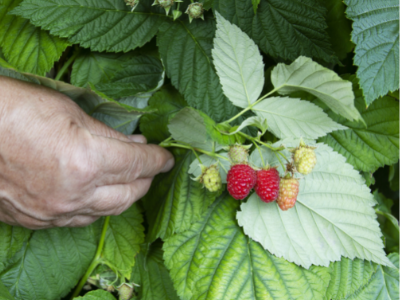There are 16 essential elements for the full cycle of plant growth and development. Aside from carbon, hydrogen, and oxygen which are sourced from the atmosphere and soil water, the remaining 13 mineral nutrients can be sourced from the soil.
Magnesium is one of those 13 mineral nutrients and is a macronutrient which plays a key role in plant life.
Magnesium gives plant leaves that vibrant green hue that we are all familiar with, as well as being key to enabling the process of photosynthesis. Without it, plants won’t be able to harness the sun’s energy for growth and development, which is why magnesium deficiency can be so detrimental to plant health.
Magnesium’s role in plant health
The green hue that gives plants their vibrancy is chlorophyll, a light-absorbing pigment within the plant cells. Chlorophyll absorbs energy from blue and red light waves and reflects green light waves which give plants their green appearance. Magnesium is a central component of chlorophyll which supports the vital function of absorbing sunlight for photosynthesis.
We have photosynthesis to thank for much of life on earth. Plants, algae and even some types of bacteria rely on this process for growth by harnessing sunlight to produce oxygen and energy in the form of sugar or glucose.
During photosynthesis, the plants take in carbon dioxide and water from the air and soil. The plant cells oxidise the water (H20) (loses electrons) converting it into oxygen (O2) which is released back into the air. The carbon dioxide (CO2) is converted into glucose which is stored as energy within the plant cells.
Whilst magnesium is crucial for the prominent function of photosynthesis, it is also needed for:
- Cell division
- Protein formation
- Plant respiration
- Phosphate metabolism
- Nitrogen metabolism
- Protein synthesis
- Water uptake
Symptoms of magnesium deficiency
So we understand that magnesium is essential for plant life and overall plant health, but how do we identify a magnesium deficiency in our plants? Like many other nutrient deficiencies, there are visual cues as to what nutrients they need.

With magnesium being a component of chlorophyll, the most obvious symptom is chlorosis (yellowing of the leaves). Or more specifically interveinal chlorosis, yellowing of the leaf with the veins remaining green. Yellowing of leaves is a common symptom of other nutrient deficiencies, the key on identifying this as a magnesium deficiency is determined by the location of the interveinal chlorosis.
The first signs of magnesium deficiency appear on the older lower leaves as magnesium moves towards new growth. As the deficiency develops, chlorosis can move to the younger leaves as well. Eventually as chlorophyll reduces, some plants may display red, purple or brown tints. With severity, the interveinal chlorosis can lead to necrosis (death of leaf tissue) along with slow plant growth and poor crop production.
The photo below shows a magnesium deficiency in raspberry plants.

Magnesium deficiency in tomato plants
Magnesium is a common nutrient deficiency seen in high tunnel crops, tomato plants are especially prone. Typically the magnesium deficiency symptoms appear mid-season when the tomato plant is bearing heavy crop. Tomato plants do require frequent feeding, however over application of tomato feeds or use of high potassium fertilisers (potash) can create a magnesium deficiency. This is because the plant will uptake potassium over magnesium. Both nutrients are required but the balance can easily be thrown out with overfeeding.
Yellow leaves on tomato plants
Yellow leaves on tomato plants can be caused by a magnesium deficiency, however there are a number of other causes that can also cause yellowing of leaves (also known as chlorosis.)
Other common causes:
- Under or overwatering
- inadequate aeration (soil too compact)
- Transplant shock of seedling
- Diseases such as blight
- Other nutrient deficiencies (nitrogen deficiency can also cause yellowing of tomato leaves)
For a magnesium deficiency, remember to look for interveinal chlorosis and observe where the yellowing of leaves is located on the plant. With more severe magnesium deficiency in tomato plants, you may even get hints of purple and lower leaves dying off. The crop yield will also be poor.
The possible causes of magnesium deficiency in plants
Magnesium can easily leach out of light, sandy, acidic soil with high rainfall. And in the cases of over-application of fertiliser such as potash (potassium), the plants will uptake potassium instead of magnesium, leading to a potential deficiency in magnesium.
Possible causes of magnesium deficiency:
- Heavy rainfall
- Light sandy soil
- Acidic (low pH) soil, Low pH soils reduce solubility of magnesium and becomes less available
- Potassium-rich soils
- Infrequent or inefficient fertilisation
- Cold, wet environments
- High EC growing medium
How to provide plants with magnesium
To provide your plants with an adequate supply of magnesium, begin with a good foundation of rich organic compost. Not only does this provide a good supply of nutrients such as magnesium, it also has the added bonus of conserving moisture in the soil to prevent nutrients from leaching out during heavy rainfall.
However, take care that there isn’t too much magnesium as this will prevent calcium uptake which would stunt plant growth. All plants require a balance of all types of nutrients to promote ultimate plant health and growth.
In cases where there is a magnesium deficiency along with low soil pH (less than pH 5), it is recommended that an application of dolomitic limestone (calcium magnesium carbonate) is used to rectify the pH levels to help with magnesium uptake. The Bluelab pH Pen offers a simple and practical solution to measuring your soil pH.
When the EC (electrical conductivity) is too high, rinse or feed with normal drinking/tap water only. In indoor growing conditions, keep the root temperature between 20-20℃. Use the Bluelab Conductivity Pen to give you both EC and temperature readings on the go. These are all factors worth monitoring in order to help with the uptake and maintenance of optimum magnesium and with other essential nutrients.
Can Epsom salts be used to help a magnesium deficiency?
Fortunately the fix for a magnesium deficiency is fairly easy and an inexpensive one. A simple application of Epsom salts provides an effective remedy. Create a foliar feed spray made up of 2% solution of Epsom salts and apply 4-5 days for about a week. It helps to dissolve the salts in warm or hot water, but does allow for the solution to cool before application. Spray the foliar feed onto the leaves in the morning before it gets too hot in the day as the pores on leaves close up to retain its moisture.
However, prevention is always better than treating a nutrient deficiency and the best way to do this is to provide your plants with a layer of rich organic compost on an annual basis. This is a simple and effective way to ensure your plants get an adequate continuous supply of magnesium over the year.
Monitoring your fundamental plant health parameters will also help keep, pH, temperature and EC in check.
Further resources
Here are some useful resources to expand on your understanding of magnesium deficiencies, other nutrient deficiencies and useful plant measuring parameters to help you with your growing journey.
How Epsom salts can help with a magnesium deficiency
Managing pH and a magnesium deficiency
Yellow tomato plant leaves and what to do about them
Features products:
Bluelab pH Pen
Bluelab Conductivity Pen



%20(1).png?height=100&name=Blog%20Author%20Bio%20Image%20500x500%20(2)%20(1).png)


Submit a comment